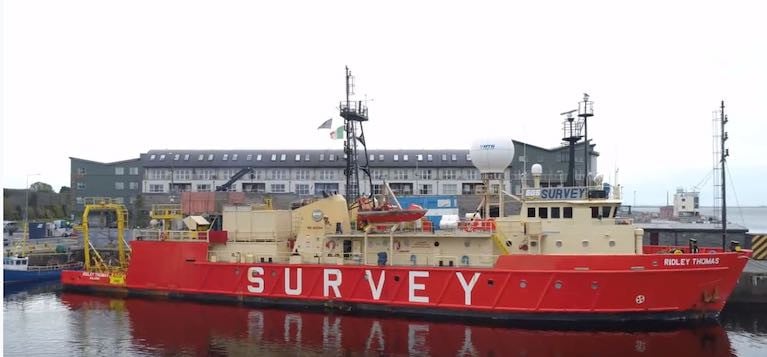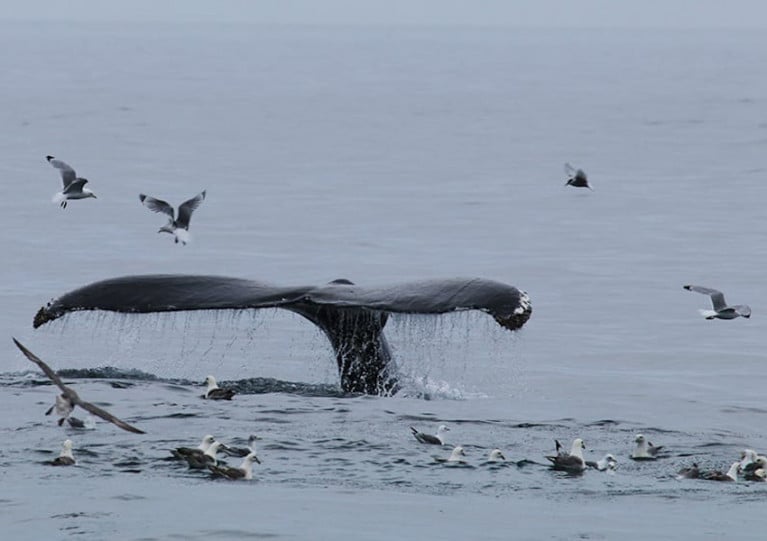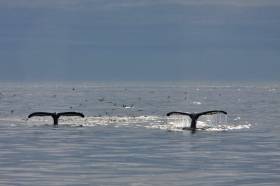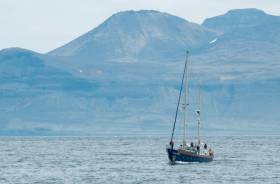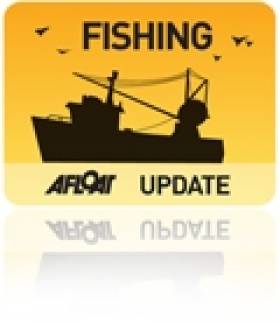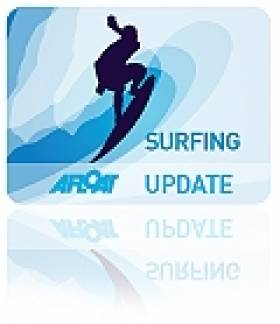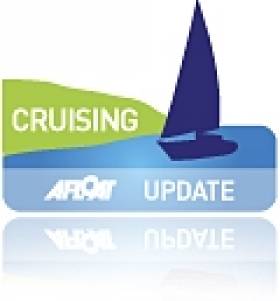Displaying items by tag: Iceland
Iceland Set to Halt Commercial Whaling From 2024
Falling demand for whale meat has prompted Iceland to announce and end to commercial whaling from 2024, as RTÉ News reports.
The move will leave Norway and Japan as the only countries that hunt whales for commercial purposes.
In an article published in the Morgunbladid newspaper, Icelandic fisheries minister Svandis Svavarsdottir said: “There is little proof that there is any economic advantage to this activity.”
Despite having sizeable annual quotas for minke and fin whales, neither of Iceland’s two main licence holders have hunted whales for a full season since 2018 — and only one has been killed in the past three years.
Meanwhile, among other issues affecting exports, Japan’s resumption of whaling has all but eliminated demand for such meat from the Icelandic fishery.
Iceland’s relationship with the whales in its waters was documented in a 2020 film that followed an Irish Whale and Dolphin Group expedition in search of humpback whales, as previously reported on Afloat.ie.
Thunder Child II Nears Greenland Coast in Arctic Adventure
Continuing their Arctic adventures, the crew of Safehaven Marine’s Thunder Child II followed Saturday’s 200nm cruise from Reykjavik to Ísafjörður in Iceland’s far north-west with a 400nm crossing of the Denmark Strait to East Greenland.
“We managed to get some 30nm from the Blosseville Coast, but running through very heavy fog for 40 miles and navigating through drift ice with zero visibility was extremely challenging and somewhat dangerous,” the team commented on social media.
“During the journey we found some wonderful icebergs off the Greenland waters and managed to fly the drone capturing some epic footage.”
As previously reported on Afloat.ie, the state-of-the-art powerboat set a new record time (verification pending) for the crossing from Ireland to Iceland in under 32 hours at the weekend.
Dun Laoghaire Harbour Call in for Ireland-Iceland Rowing Boat Crew
A Greystones County Wicklow-based challenge to row from Ireland to Iceland next Spring made a preliminary call into Dun Laoghaire Harbour last week.
Led by James Murray, the expedition aims to "safely get from Ireland to Iceland under human power alone. No motors, no sails".
The schedule is to set off from Dublin, Ireland in Spring 2021 and for different crew members to join for legs on the way to Iceland.
As Murray explains on his website, row to iceland.com, "each team member has their own reasons for joining, but we all share an appreciation for the beauty of the places in-between and that seemingly extraordinary thing are possible".
Departing Dublin in April, the 3000km route will follow up Ireland's east coast before crossing to Scotland.
Following the Scottish coast, the plan is for the rowing boat to stop into fjords and towns along the way.
The plan then is to cross to the Orkney Islands and Shetland Islands before preparing for the big push to the Faroe Islands and then Iceland.
The trip is expected to take three to six months
Murray also asks on the campaign website that if you have experience with part of this route "we'd love to hear from you to help inform our plans".
Galway Seabed Survey for Submarine Fibre Cable Between Iceland & Ireland
Iceland has selected Galway as the European landing location for international telecommunications cables.
Farice, a company fully owned by the Icelandic Government, currently owns and operates two submarine cables linking Iceland to Northern Europe.
It has been undertaking preparatory work for a new submarine fibre cable from Iceland to Europe since early 2019.
A survey ship named Ridley is now exploring suitable seabed approaches from Galway out to the boundary of the Irish exclusive economic zone (EEZ).
 The 58-metre Ridley Thomas (IMO: 8112744) is a Research/Survey Vessel built in 1981
The 58-metre Ridley Thomas (IMO: 8112744) is a Research/Survey Vessel built in 1981
Farice chief executive officer Thorvardur Sveinsson said that “after careful consideration of many factors, Galway was selected by Farice as the European cable landing location”.
“The Icelandic landing site will be on the Reykjanes peninsula with the final location to be decided during the winter 2020/2021,” he said.
“ This coupled with Galway’s reputation for business, education and hospitality will lead to a win-win situation. The enhanced global activity provided by the system will be a catalyst for attracting high tech business to the city and the regions,” he said.
The company said the project could result in a new submarine fibre cable between Iceland and Ireland becoming operational within two years from financing being secured.
“Ireland has many important attributes that make it attractive as a destination for this new cable from Iceland, over and above the relatively short distance between the two countries,” Mr Sveinsson explained.
 Ireland is at the nexus of new trans-Atlantic connections - A map showing the new cable route between Iceland and Ireland that could be operational within two years
Ireland is at the nexus of new trans-Atlantic connections - A map showing the new cable route between Iceland and Ireland that could be operational within two years
“Ireland is at the nexus of new trans-Atlantic connections, is a centre of choice for European operations for many international businesses and has a rich and diverse pool of skilled labour in its workforce. Ireland has thus firmly established itself at the forefront of the development of Europe’s digital infrastructure and as such is an important connection point for a new submarine cable between Iceland and Europe,” he said.
“It is often perceived that international telecommunications are carried out by satellite. This is a common misconception and in reality, the vast majority of global communications is carried on fibre optic cables and particularly sub-sea cables,” he explained.
“The capacity of such cables is quite incredible and a single pair of fibre strands could satisfy the demands of most of Galway city,” he said.
“Due to the very high capacity of modern systems, subsea fibre cables are incredibly small in size (approx. 25mm diameter) and are very fast and non-intrusive to install. The overall benefits greatly outweigh the short-term inconvenience during the installation,” he said.
“The presence of the Farice system landing in Galway will provide direct high capacity links to Iceland but also to Northern Europe via Denmark and the UK and will greatly increase capacity and connectivity in Galway city and the regions,” he added.
The company currently operates the FARICE-1 cable between Iceland and Scotland with a branch connection to the Faroe Islands and the DANICE submarine cable between Iceland and Denmark.
A third submarine cable Greenland-Connect links Iceland to Canada and US. The Icelandic government said the fourth cable would “increase further the security and resiliency of Iceland’s international telecommunications.”
The new cable could cost up to €2 million during the research phase, with the actual laying estimated last year at around 32 million US dollars.
Documentary On Irish Mission To Find Humpback Whales In Arctic Circle Now Streaming Online
A new hour-long documentary following the Irish Whale and Dolphin Group (IWDG) on a unique research expedition to the Arctic Circle is now available to rent and watch on demand.
On The Trail Of The Humpback Whale tells the story of the IWDG’s weeks-long passage to Iceland two years ago in search of humpback whales, building links with the country and its people among the way.
Tony Whelan of Canola Pictures — which also produced The Humpback Whales of Cape Verde — was along for the voyage, documenting the team’s encounters with local people and marine wildlife alike.
The IWDG previously brought the story of their adventure on a nationwide tour — and now it can be enjoyed at home on your choice of computer, tablet, smartphone or streaming box.
Irish Whale & Dolphin Group Continues Its ‘Trail Of The Whale’ Library Tour Across The Country
The Irish Whale and Dolphin Group (IWDG) is bringing stories from the Celtic Mist’s historic marine wildlife survey voyage around Iceland to libraries and other venues nationwide.
Already the IWDG has visited 10 venues across eight counties in its ‘On the Trail of the Whale’ tour, which continues tonight (Tuesday 19 February) at 7pm in Killarney Library.
In May last year a crew of marine scientists and enthusiasts set sail on the IWDG’s research yacht for a weeks-long return passage to the edge of the Arctic Circle in search of humpback whales, building “strong links with Iceland and its people” along the way.
Last month, IWDG members began sharing their experiences from the rewarding mission in images, stories and video of the voyage to audiences in libraries and other venues across the island of Ireland — beginning on 14 January at DLR LexIcon and since visiting Galway, Tralee, Monaghan town and Arklow, as well as Bangor and Warrenpoint in Northern Ireland and Dublin’s Poolbeg Yacht Club.
“Through the tour, we want to encourage people to get involved,” IWDG’s chief science officer Dr Simon Berrow told the Irish Examiner. “If even one person at every event we do gets interested [in marine life] and gets motivated, that’s fantastic.”
The Irish Examiner has much more on the story HERE.
#CelticMist - The Celtic Mist’s historic marine wildlife survey voyage to Iceland is complete, with the Irish Whale and Dolphin Group (IWDG) recording nearly 100 sightings over the course of the month.
The research yacht set sail with a crew of wildlife enthusiasts and marine scientists in late May for the 2018 IWDG Humpback Whale Expedition, taking less than a week to cross the North Atlantic to the edge of the Arctic Circle.
Week one began on 31 May on arrival at Vestmannaeyjar in the south, following a clockwise route round to Reykjavik — minke whales, humpbacks and dolphins recorded along the way.
Though sightings were slim in number, the Celtic Mist team hailed “great engagement with both Icelandic people and people from overseas working in Iceland”.
“From the Marine and Freshwater Research Institute to tour operators and guides and visiting scientists, all have given us insights into life in Iceland and whaling and whale-watching issues,” said the IWDG’s Simon Berrow.
Week two was spent amid poor conditions in Iceland’s remote West Fjords — with sea ice and stormy weather keeping the Celtic Mist firmly in part at Isafjordur for the first few days.
But later in the week, patience was rewarded with the sighting of five humpback whales, the majority of a group known to the area but never recorded further south-east in Irish waters.
Week three brought a crew change and a break in the weather allowing passage to the north-west peninsula of Hornstrandir — still a challenge with rolling seas overnight.
“In almost 21 hours of sailing in some of the most productive waters on the planet and in reasonable viewing conditions and 24 hours daylight, we didn’t have a single cetacean sighting,” remarked IWDG sightings officer Pádraig Wholley.
“It would be inconceivable that Celtic Mist would survey for a whole day in Irish waters without a single sighting entry being input into the logger software that we were running throughout.
“This was our first strong evidence that if you want to find marine mammals in Icelandic waters, that open waters may not be the place to be looking.”
Week four took the IWDG to the “poorly surveyed” East Fjords, via the Arctic Circle — in bright midnight sun instead of the common sea fogs. Sightings remained consistent, with no big whales spotted on Iceland’s eastern coast.
The Celtic Mist was due back in Ireland by tomorrow (Friday 13 July) when the mammoth task of sorting through all the recorded data and images begins.
But perhaps the greatest takeaway the voyage is in the connections made with Icelanders around their coastline, suggests Berrow.
“We have achieved all our objectives and built strong links with Iceland and its people. We have discussed fishing, whaling, whale watching and the weather.
“We have a great appreciation of these issues and the differing perspectives and challenges faced which ultimately will be decided by Icelanders.”
Coveney Blasts Iceland's 'Irresponsible' Mackerel Quota
#Fishing - Mackerel quotas will be the focus of discussions among European fisheries ministers in Brussels today as Ireland seeks a reduction of Iceland's share.
As RTÉ News reports, Marine Minister Simon Coveney will seek "strong and decisive action" against Iceland and the Faroe Islands unless the European Commission reports progress in talks over the realignment of mackerel catch limits.
Iceland's quota for mackerel increased from 2,000 tonnes in 2009 to a whopping 146,000 tonnes just two years later as stocks of the staple fish soared - partly due to migration from more southerly European waters.
But Minister Coveney has blasted Iceland's move as "irresponsible and unacceptable fishing".
The talks come in the wake of fruitful reform of the Common Fisheries Policy led by the minister as president of the EU Fisheries Council during Ireland's EU Presidency in the first half of this year.
Spectacular Winter Surfing Captured On Video At Home And Abroad
#Surfing - Iceland, of all places, may not be known as a surfing hot-spot - but Irish wave rider Eoin McCarthy Deering has made something of the freezing swell, as the video above demonstrates.
The clip, via IrishCentral, was captured using one of the now ubiquitous GoPro portable HD cameras that enable extreme sports enthusiasts to record footage right from the centre of the action.
Closer to home, Epic TV reports on yet more incredible sessions at Mullaghmore Head and Aileens, this time by visiting surf pros Kohl Christiansen and Aritz Aranburu - see the videos below.
Christiansen took on the giant waves off Sligo - which are featured once again among the nominees for the Billabong XXL Big Wave Awards - while Aranburu headed to Clare with British rider Tom Lowe for a run at the famed surf break.
Kohl Christiansen at Mullaghmore Part 1:
Kohl Christiansen at Mullaghmore Part 2:
Aritz Aranburu at Aileens:
Galway Sailing Cruise to Iceland, Greenland Lecture at GBSC
#gbsc – Nick Kats, the owner of a 39 foot steel ketch will talk about a sail from Clifden in county Galway to Iceland, East Greenland and Jan Mayen Island.
Kats, a naturopathetic Doctor from Connemara undertook the cruise in 2012 after several months of planning.
His talk takes place at Galway Bay Sailing Club (GBSC) clubhouse next wednesday night the 6th March at 8.00pm. It is the last of GBSC's Winter/Spring talks series.




























